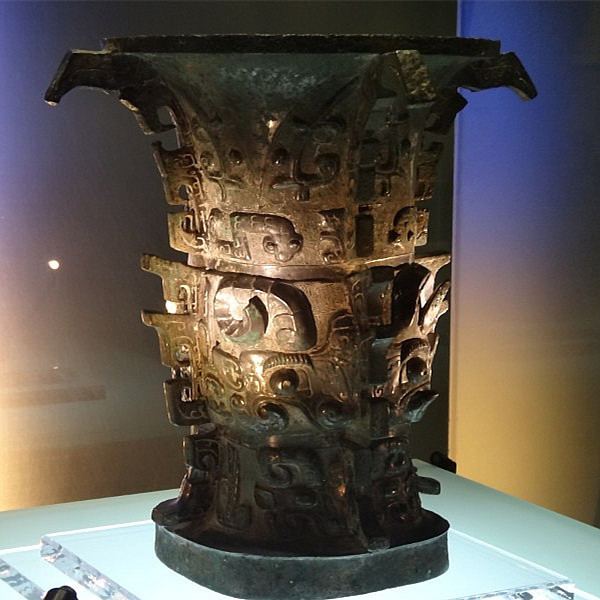 | ||
The He zun (何尊) is an ancient Chinese ritual bronze vessel of the zun shape. It is more than 2,700 years old from the era of Western Zhou, and famous as the oldest artifact with the written characters meaning "Middle Kingdom", that is, "China" (中國) in a bronze inscription on the container. Today it is in the Baoji Bronze Museum (宝鸡青铜器博物院) in Shaanxi.
Contents
Dimension and significance
The vessel is 38.8cm tall, 28.8 cm in diameter and weights 14.6kg. Inside the container, at the base, it contained 12 rows of 122 inscribed Chinese characters. Of the 122 characters, 119 are identified while 3 are unknown. Among the characters is the phrase (宅茲中國) inscribed in Zhou era form. This is the earliest known artifact to contain the word "Middle Kingdom/China (中國)". It is also the earliest known vessel bearing the character de 德. He zun later became one of only 64 designated pieces of historical artifacts that can never leave Chinese soil.
History
The construction of the city of Luoyi (洛邑) was documented in two chapters of the Classic of History. This vessel also supports the claim. Historians believe King Wu of Zhou was at Haojing (鎬京) at the time after the construction of Luoyi. The record shows King Cheng of Zhou established his residence in Chengzhou (成周) in his 5th year. Most scholars consider this was 5th year after Duke of Zhou handed over the government.
Discovery
The lost artifact was discovered by a Chen family. Behind their house in Baoji was a 3 metre tall cliff. One cubic metre of the piece was sticking out from the soil. In 1963 the second son of the family dug out the piece thinking the part that sticks out would hurt somebody. The piece revealed a taotie design, but the family did not know it was a national treasure. They then used it as a food storage container at home. On August 8, 1965 the family struggled with financial difficulties and sold the piece along with other junk to a waste center in Baoji for 30 yuan.
In September 1965 a worker in the waste center informed an expert about the bronze piece. The expert recognized it as a Zhou dynasty artifact and brought it back to a museum. In 1975, near the end of the Cultural revolution, the State Administration of Cultural Heritage sent the piece to the Shaanxi relic bureau. Ma Chengyuan, a bronze expert at the Shanghai Museum, recognised its significance.
In 1976 the PRC cultural bureau organized an art exhibition to the United States. The US requested this piece join the exhibit and offered a US$30 million protection coverage.
